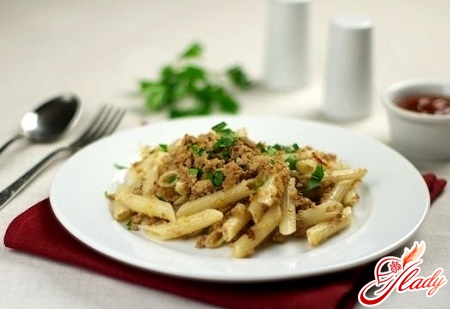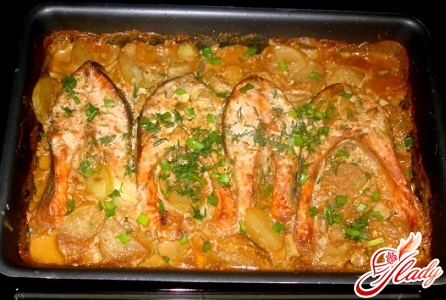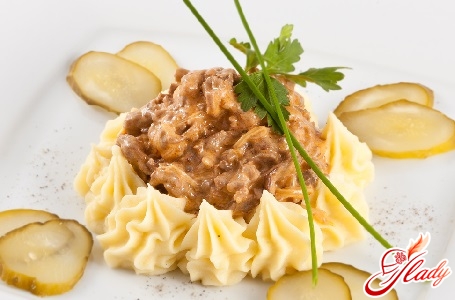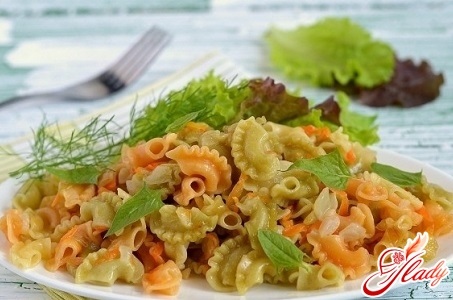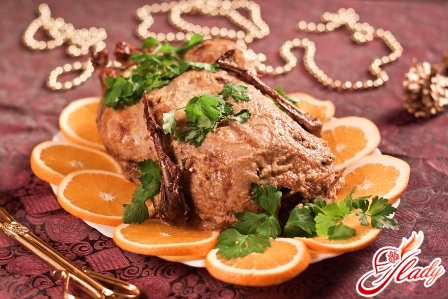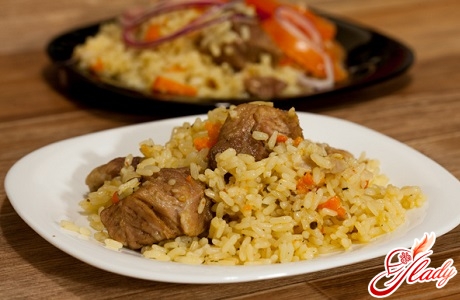
Traditionally, pilaf is considered an eastern dish.cuisine. The variety of options for a classic dish can pleasantly surprise even a true gourmet. And each recipe has its own "zest". Usually, pilaf is prepared from lamb, pork or beef, less often - from chicken or minced meat, and in experimental cooking they do not forget even about seafood and fish components. However, such combinations have appeared only recently. In Uzbekistan and the Caucasus, special seasonings are used for flavor: turmeric, rosemary, caraway, cumin, red and black peppers. Usually, the dish is cooked in a cauldron over a fire - this is, so to speak, a classic of the genre. Naturally, you cannot resort to this method at home, so a special goose pan or saucepan with a thick bottom comes to the aid of housewives. Today we will consider a more modern way of preparing the dish - in this section we will tell you how to properly make pork pilaf in a multicooker. An easy-to-use kitchen appliance is a real find for a woman. Firstly, thanks to the non-stick coating, you save on oil, which means you keep your health and figure safe and sound. After all, in a multicooker, dishes, so to speak, simmer in their own juices, while the products do not burn, but turn out tender and soft. Soups and porridges are cooked here, vegetables are stewed. Here is one of the important points that allows you to significantly save time and effort: using a multicooker, you do not have to wash mountains of dishes. After all, all stages of processing - from frying to boiling - the ingredients take place directly in the device itself. You can cook almost any dish in it. And now let's return to Eastern cuisine: thanks to the instructions below, you can easily make pilaf with pork in a multicooker. You will see that the dish is not one iota inferior to its analogue cooked over a fire. We will consider several options for the dish: from classic Uzbek to more modern combinations of products. After all, you must admit, you won't always find special seasonings in the refrigerator, and the lamb that is included in the traditional pilaf recipe is quite fatty, so it won't suit every stomach. So let's modernize the dish a little, and you'll see what comes of it after mastering one of the proposed culinary instructions.
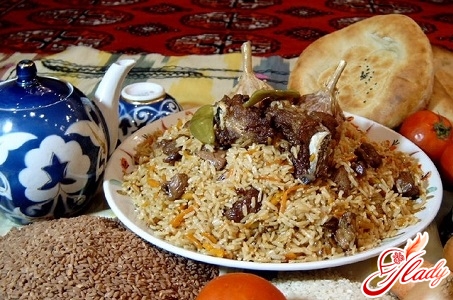
Pilaf with tender pork and vegetables
It's no secret that todayrice is one of the main products widely used in various nationalities. On average, this cereal is present in the diet of more than 60% of people around the world. All kinds of dishes are prepared from it: from salads, soups, porridges and ending with delicious desserts. Today we will talk about a dish of real men, which is familiar to almost everyone. Traditionally, juicy and fresh lamb is selected for cooking pilaf. However, having decided to master this recipe, do not forget that the meat is very fatty, so the dish turns out to be incredibly satisfying and heavy for the stomach. Not every organism will react well to such food. In order not to risk either your health or the well-being and well-being of your loved ones, we advise you to use a more “gentle”, but no less tasty recipe at home. Let's make pilaf based on pork, if you have a multicooker, be sure to stew the products in it, otherwise take a regular saucepan. Ingredients:
- 1/2 kilogram of fresh, scarlet pork (try to choose meat with a minimum amount of fat)
- 450 grams of round-grained rice
- two to three medium carrots
- red bulb (meaning sweet Crimean) - one piece
- 45 ml of olive oil (if there is none, take the usual vegetable)
- 0.5 teaspoon barberry
- the same amount of zira
- ground pepper (red or black) - optional
- three garlic cloves
- salt - for your individual taste
Method of preparation:First, let's take a short excursion into the basics of cooking. The following information will be useful not only for cooking pilaf - no matter what rice dish you take on, remember that the first thing you need to do is thoroughly rinse the grain. There is even a special "rule of seven waters". Pour the grain into a deep bowl and pour cold running water over it until the liquid eventually becomes crystal clear. After all, as you know, at first the water from the rice is cloudy, white. There is another way to rinse the grain - in a saline solution. To do this, add table salt to the purified water (take a large spoon per 1000 g of rice). Thanks to such simple manipulations, the flour or, as it is also called, powder contained in the product, will go away with the liquid. Then the pilaf is guaranteed to be tasty and crumbly, otherwise it may have an unpleasant, slightly bitter taste. So, let's get down to the cooking procedure itself. After thoroughly washing the rice using one of the methods described, throw it in a colander and wait until it drains. In the meantime, pay attention to the rest of the ingredients. Peel the carrots, and peel the onions and garlic. Then chop the first two products into small cubes of the same size. Turn on the multicooker to the "Frying" mode, pour in a little oil and pour in the vegetables. Brown them for five to seven minutes, stirring constantly. When they become softer and acquire a different shade, add the pork, previously washed and well dried, to the dish. Chop it into large pieces and cook for about a quarter of an hour with the lid open. As soon as you do, pour purified cold water into the multicooker, which should completely cover all the ingredients. Salt the dish to your taste, then add spices. You can safely experiment with the latter, deviating from the classic recipe. However, in the traditional version, dried cumin, a little black pepper, barberry, and marjoram, and a little less often turmeric, are used to give the pilaf aroma and a special taste. It's time to switch the device to another mode called "Stewing". Close the lid of the dish and continue cooking the dish for about 40 more minutes, at the very end, add the washed and dried rice groats. By this time, some of the liquid will have evaporated, so you will have to pour in a little more water, which should ideally cover the ingredients by only one centimeter. Otherwise, the dish will turn out too "wet" and sticky, and we don't need that. After adding the groats, cook the dish for another fifteen minutes. Then add a few whole cloves of garlic and stir. Close the lid and let the pilaf simmer for a while. If you followed the instructions exactly and did everything correctly, the dish will be crumbly and incredibly aromatic. Serve it with fresh vegetables, herbs and dry red wine. Bon appetit and a hearty meal!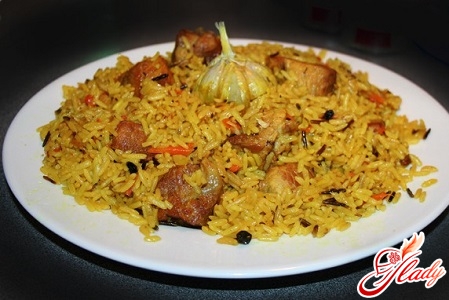
Plov on a modern style with raisins and stuffing
Let's deviate from the classic recipe andLet's make pilaf, so to speak, in a modern way. We will replace traditional meat with pork and beef mince, thanks to which the price of the product at the end will be significantly reduced. This method of cooking pilaf is suitable for emergency cases, when there is a catastrophic lack of time, and you don't want to leave your family members hungry either. In this case, the culinary procedure will be reduced by about fifteen minutes, or even more. Let's see what comes of it. Ingredients:
- fresh pork or ground beef (you can use a mixture of two kinds of product) - 650-700 grams
- 125 grams of white onions
- fine table salt - put to taste
- laurel leaves - if desired
- a few small pinches of ground black pepper
- large orange carrots
- 0,5 heads of garlic
- three to five grams of turmeric
- 35-50 grams of golden raisins
- 1/3 tablespoon paprika
- 20 ml of refined olive oil
Method of preparation:Here is the first thing you should start with, rinse the rice as thoroughly as possible until crystal clear water flows from it. Then throw the product into a colander and leave it to dry. Then pepper and salt the mince to your taste, pass it through a meat grinder two or three times. This way you will get rid of unnecessary lumps, thanks to which the dish will be more tender and juicy. Peel the onion and garlic, peel the carrots. Then rinse the raisins under the tap and pour boiling water over them, put aside for a quarter of an hour. The berries should be infused, as soon as they are soft enough, get rid of excess liquid and squeeze them out using a special paper towel. Now we proceed directly to cooking: pour the amount of vegetable oil specified in the recipe into the preheated multicooker, operating in the "Baking" mode. Then chop the onion and carrot into medium cubes and pour them into the pan. Without closing the lid, fry the vegetables until they change color and become soft. When this happens, add the previously prepared minced meat to them. Continue cooking, periodically stirring the mixture with a wooden or silicone spatula - made of a special material, they do not scratch the heat-resistant surface of the multicooker. As soon as the minced meat turns lighter, combine the above ingredients with the already prepared rice. Stir the mixture with vigorous movements, then pour hot water over it so that it covers the products by only one or two centimeters. Focusing solely on your taste preferences, add salt and all dried seasonings, with the exception of ground paprika. Regarding the spices, note that you should not be afraid to overdo it, because the aromatic pilaf turns out surprisingly appetizing. At the very end, add raisins, then slam the lid of the pan and continue to stew the dish, remaining in the same mode. After about half an hour, add the garlic, having previously peeled and chopped it into large pieces. A little more, and the aromatic, juicy, slightly sweet thanks to the golden berries, minced meat pilaf can be served on the table. We hope you will like this modernized recipe.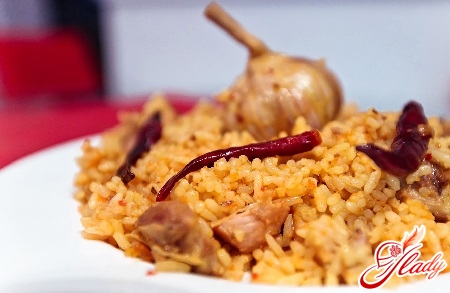
Pilot "Uzbek motives"
Finally, we suggest considering the classica recipe for an incredibly aromatic and satisfying pilaf. Only if in its traditional form it is made from lamb, then we will take pork. And if you want, use both types of meat in equal proportions. The dish also includes peas - they should be soaked in cold water in advance, as early as possible, for example, the night before. The product should soften well, as for spices, we added barberry, red pepper, cumin, which are used in Uzbek cuisine. Of course, ideally the dish is cooked over a fire, but you won’t take your family out into nature to taste pilaf, will you? Therefore, we suggest making it in a multicooker, it will be even healthier. Ingredients:
- carrots - four pieces
- 550 g of any rice
- olive oil
- 60 g of peas
- three large bulbs
- 600 g fresh pork tenderloin
- a handful of soaked raisins
- barberry, and red ground pepper
- garlic - if desired
- zir and salt
Method of preparation: Не забудьте заранее — за пару часов до начала всех приготовлений — залить горох холодной водой. Иначе он останется твердым и испортит будущий плов. Затем промойте под краном рис, пока с него не будет стекать чистая, прозрачная жидкость. Запомните следующее правило: приобретая мясо для узбекского кушанья, берите продукт из расчета 1 кг на четыре-пять взрослых человека. Тогда оно выйдет сытным и похожим на традиционное блюдо. Сначала промойте свинину, после просушите ее полотенцем и срежьте лишний жир, затем порубите на крупные кубики. Кстати, откроем небольшой секрет: плов приготовится гораздо быстрее, если вы подержите рисовую крупу около часа в прохладной воде. Вот увидите, насколько это сэкономит ваше драгоценное время. Теперь подготовим овощи: очищенную морковку разделайте тонкой соломкой, а репчатый лук — средними кубиками. Если используете чеснок, снимите с него шелуху, после каждый зубчик разделите ножом на две-три части. Не добавляйте слишком много, иначе аромат чеснока перебьёт вкус самого плова. Когда справитесь со всеми приготовлениями, включите мультиварку в режим «Жарка» и налейте в нее несколько миллилитров масла. Рекомендуем приобрести рафинированное оливковое, по сравнению с другими видами растительного продукта, оно считается более полезным. Высыпьте в посуду лук, подрумянивайте его при постоянном помешивании. Когда он станет светлее и мягче, введите морковку. Продолжайте готовить в том же режиме, периодически переворачивая ингредиенты ложкой. Затем наступает черед мяса — добавьте его в посуду и тушите не меньше 40 минут. Когда справитесь, залейте продукты кипятком, который должен полностью их покрыть. Внимание, сейчас самое время ввести горох и специи: барбарис, горьковатый красный перец, зиру, не забывайте про соль. Даже если вы немного переборщите с последней, не беда. Все излишки впитает в себя рисовая крупа, которая, кстати, закладывается в самый последний момент, когда зирвак — так называют массу из обжаренных овощей и мяса — практически готов. После добавления риса переключите кухонный прибор в режим «Тушение», плотно закройте крышку и подождите 45 минут. По истечении указанного времени проверьте плов – крупа должна получиться рассыпчатой. Сделайте в ней неглубокую выемку, высыпьте в нее предварительно замоченный изюм, потом добавьте несколько чесночных зубчиков. Если заметите, что вода уже полностью испарилась, долейте примерно 1/4 стакана горячей жидкости. Кстати, если вы делаете плов из свинины или говядины, можете тушить его на мясном бульоне. Тогда он получится более сытным и насыщенным, а вот с бараниной экспериментировать не стоит, она сама по себе достаточно жирная. Чтобы смягчить этот эффект, рекомендуется подавать блюдо с большим количеством зелени, например, укропа или петрушки. Нередко на стол ставят пиалу с зёрнами граната или винным уксусом. Кислота поможет устранить излишнюю жирность. Бытует мнение, что плов — исключительно мужское блюдо, которое и готовить должен глава семейства. Может, так оно и есть, однако в наших широтах большая часть обязанностей по дому лежит на женщине. Поэтому если хочется отведать аппетитное кушанье, не обязательно дожидаться, пока ваш мужчина станет к плите. Удивите его ароматным, рассыпчатым пловом на основе свинины, приготовленным в мультиварке. Если у вас нет такого прибора, возьмите обычную кастрюлю с плотным, толстым дном. Надеемся, эти рецепты приживутся в вашей семье. Желаем успехов и исключительно удачных кулинарных экспериментов.




